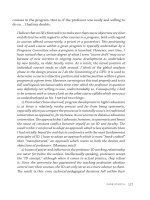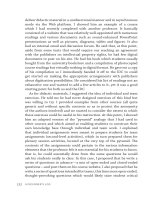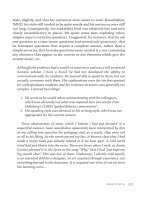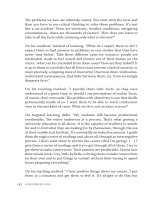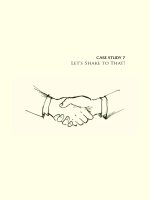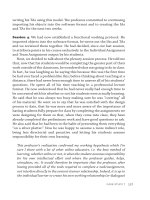A Designer’s Log Case Studies in Instructional Design- P26 ppsx
Bạn đang xem bản rút gọn của tài liệu. Xem và tải ngay bản đầy đủ của tài liệu tại đây (76.66 KB, 5 trang )
A D ES IG NE R' S LOG
112
criteria? Everyone must participate…number of student interventions?
X number of times? Even if what they have to say is not relevant to the
discussion? I don’t think so. I wracked my brain for various assessment
strategies I had seen in the literature and the idea of the “reading grid” came
to mind: as the student was doing his/her reading, they would complete
an analytical grid with which they had been provided. Granted, it is not a
direct way of measuring in-class participation. However, it was indicative
of preparation for participation, and it had the benet of being an activity
which, if carried out correctly by the student, would likely have a direct
and positive eect on participation. For how can a student participate
intelligently in a discussion if he or she has not done the necessary readings?
By assessing a student’s preparation for class, would that not put professors
on rmer ground to more accurately assess the quality and relevance of
each student’s participation? If so, this would mean that individual or even
team reading grids would need to be developed. I could already hear the
professor groaning, “more work.” On the other hand, it reminded me of the
old Québecois saying, “No money, no candy.”
Session 4: During this working session, I broached the question of how
to distribute points, how the importance of each of the activities planned
would be weighted, the reasons for awarding points as well as how many
for each activity. I shared my idea of developing reading grids which could
be used to determine who was truly preparing for the course and who
was not. I explained that I was basing my reasoning on the fact that, in
order to be able to assess something, one must have both criteria and
instruments.
is discussion also brought to mind the idea that it is harder to assess,
and award points to, a process than it is to a product unless the process
has clearly-dened assessment criteria and known performance indicators.
I have found that faculty are often forced to assess what they cannot
measure. However, it seems clear, at least to me, that the accuracy of an
assessed result is inferior to that of a measured result. But this begs the
question: “Can everything be measured?” Another problem with measuring
is the question: “Are we measuring what is truly important?” and an even
more fundamental question, “What is most important?”
113
CAS E STU DY 5
e professor agreed with the idea of developing reading grids because
she had realized that her students had diculty with several of the
compulsory texts when she had to spend considerable time explaining
the authors’ perspectives. She liked the idea of providing grids to guide
them through their readings in theory, but, as I had anticipated, she was
rather reluctant to devote the time required to developing them. In the
end, she agreed to take a crack at it, using her rst text as a model. We got
right down to it and we started reading the article together. As we read,
I asked her questions and she told me whether they were important or
not. ose she deemed most important were noted immediately. Since
she knew her texts very well, in less than an hour, we had written our rst
grid. She now saw the advantage of the reading grid system and seemed
ready to continue writing grids for the other compulsory readings in the
course. To complete the whole process, she decided to adopt the Socratic
approach, which is based on questions and answers during plenary
sessions. To sum up the approach we adopted,
• she would only ask questions to those students who had submitted
les to her, questions which she expected them to be able to answer
without looking at their notes. Consequently, students who had not
completed and sent back the grids would not be able to participate in
the discussion or be awarded participation points,
• if she noticed that the students to whom she asked questions did not
know the answers, she could decide not to award them participation
points either.
In this way, she would be able to assess both a product (the completed
grid) and a process (oral participation of students during the plenary
session), both of which were closely linked to reaching her course
objectives, particularly in terms of acquired knowledge assimilation and
accommodation (Block, ).
It has become clear to me that a designer sometimes has to consider
processes and products, the assessment of the former often depending
on the measurement of the latter. I also realize that my background in
measurement and assessment leaves something to be desired. I really must
A D ES IG NE R' S LOG
114
get in touch with a specialist in these elds so that I am better equipped to
advise professors in terms of the various options available to them.
is case ended somewhat abruptly, sadly. e professor was simply “at
out of time” and we left o with some feelings of regret, knowing that
we could have accomplished much more if we had just had more time.
Below are excerpts from an interview I conducted ex post facto, where she
reveals more about her personal philosophy learning which, I feel, is both
rich and well balanced.
Ex Post Facto interview
On creating teams: “For the rst activity, I leave it up to them, that is,
they can team up or not. en for the second activity, I create teams
in random fashion (i.e. -------…) and then after that, for the
term project, they choose their team members, to get a more ‘natural’
grouping. I have always valued teamwork.”
On how teams function: “Teams function according to what you might
call ‘self-governance.’ ey can choose to form teams of between to
members and carry out their work however they want, provided the end-
product represents both the team as a whole as well as each and every
individual in the team. Each student in the team should be able to see
themselves in what is produced. e goal of all of my activities is for them
to get other viewpoints on a given subject. In teams, they have access to
just that.”
On virtual teams: “ey get together over the phone or by email and
team presentations are delivered from dierent (videoconference) sites.”
On the link between individual activities, team activities and plenary
sessions: “e rst time I had ever done anything like that was in
developing my course with you.”
On writing objectives: “At rst, I was ‘allergic’ to objectives. Working
with you forced me to develop them a bit more, but this had a pernicious
eect as well…the students knew how things were going to unfold so well
115
CAS E STU DY 5
that they would freeze up, there was no more spontaneity…we had killed
the element of surprise!”
On the course syllabus: “ey (the students) had the full syllabus. ey
could see everything that was going to happen. Normally, I don’t give
them the course syllabus right at the beginning (of the course). Rather,
I reveal it bit by bit. e students really appreciated the portfolio that
we had developed further using the horizontal course syllabus. […]… my
teaching style involves their doing research on the ‘inside’ (internalizing)
and then, afterwards, research on the ‘outside’ (externalizing), that
is, reading what various authors have written on a subject. […] I nd
that when I provide them with too many details or when I want to do
something which focuses specically on their personal experience, it is
as though they lose focus, they get too concerned with details. Students
nd things much clearer when I use visuals (graphics)…I still use them
today.”
On her philosophy of education: “Learning is always a social phenomenon,
you are never alone. Sometimes you try to read into the minds of others,
sometimes you go out on your own, alone with your thoughts…We are the
fruit of our experience…e very fact that we exist in an environment,
in a society, means that we are never alone. We are always connected.
If I walk alone, I am still part of a couple, of a community, of all that is
living. We can reect by ourselves but the minute we make contact with
others, our reections become anchored in reality. We dene ourselves
through others. Sometimes we are of two minds, two opposing opinions,
like when we are not sure about something Others do not stop me from
being myself. Even Robinson Crusoe wasn’t alone. I feel the most alone,
in fact, when I am working with technology. I felt alone because, being
naturally very independent, I get a feeling of dependency, a feeling of
solitude…I really felt it when I went to see my students at their sites. I had
felt some tension among my students when I was teaching at a distance
but that wasn’t enough to convince me that there was any. Because I was
at a distance, I couldn’t feel the eects of my teaching. But when I visited
their sites, I realized how accurate my impressions at a distance had been.
When I came back, I realized that my perception was right. I could feel
what they [the students] were feeling.”
A D ES IG NE R' S LOG
116
On assignments: “I usually give them a term project with several parts,
with all the parts related to each other of course.”
On the design process: “It was a bit hard for me. We started our work
before the strike and we nished after the strike. I was giving a distance
course for the rst time. I was happy that I was going to have someone
to look at my pedagogy with me. What I remember about you is that
you didn’t want to change what I was doing. First of all, you sought
to understand my method and then how you could help me reach my
objectives. You are the person that I have talked to the most about my
teaching since I arrived here [at the university]. I have been here for more
than three years. At the start, I was afraid of what you were going to tell
me, but that didn’t last. You have a talent for turning ideas into images. I
talked to you about my teaching and felt as though I was actually teaching
you something. I had the feeling that we were doing something together.”
On student passivity and teaching at a distance: “We still have a lot of
discussions in spite of the distance involved. My on-campus students
were the most passive. ey were the ones who seemed to have the most
diculty coming to grips with it [the hybrid model of teaching]. I believe
they were telling me that I was more ‘connected’ to the remote-classroom
students, more in tune with their needs. In the second course, those on
campus appeared to be struggling. ey seemed to be saying ‘we could
have had a real course’ while those at a distance seemed to be saying
‘good thing we have this, otherwise we wouldn’t have any course at all.’”
On the link between assignments: “Preparation is carried out individually
and there is a team assignment. I give students a case study-based
problem; they read it individually and reect upon it so that they can
then talk about it to their team. During the plenary session, we share
reections and identify problem areas…we pool thoughts and ideas.
My goal is to get students and teams to develop their own views and to
have them prepare a debate for the plenary session. And since each team
works on a dierent problem, everyone participates in the debate. e
idea is to show them that everyone can participate, that everyone has
their own ideas.”



